Spikes are a common trait in dinosaurs. Many of the dinosaurs that lived millions of years ago were extremely deadly, and are some of the fiercest apex predators in history. Dinosaurs like the Velociraptor, T-rex, and the Spinosaurus are some examples of the deadliest dinosaurs.
Carnivorous dinosaurs relied on a variety of animals to feed on. To defend themselves many herbivorous dinosaurs had spikes and armor as a natural defense. In this article, you will learn about 9 different dinosaurs with spikes.
Fossils are one of the greatest resources in learning about dinosaurs and are even helpful after millions of years. Dinosaurs used spikes as a defense, but there are also other theories as to why these ancient reptiles grew large spikes from their body. Here are 9 dinosaurs that have spikes and what you should know about each one.
1. Ankylosaurus

The heavy build of the Ankylosaurus gave them a slow speed of around 6 mph.
©Warpaint/Shutterstock.com
A member of the Ankylosauridae family, the ankylosaurus is the largest member of its family. This species lived in North America during the Cretaceous period. Spikes covered their body to protect them from predators. These dinosaurs stood around 5.6 feet tall (1.7 meters), and had a lengthy body of around 24 feet (7.3 meters). Ankylosaurus are herbivores, eating a variety of low-lying plants.
Ankylosaurus was a browsing herbivore and only use their bodily weapons for defense. The tails of this species are similar to a medieval club and can quickly swing at any threat that decides to provoke this beast. Spikes cover the back, head, and tail of the Ankylosaurus, making it dangerous to get close to.
2. Kentrosaurus
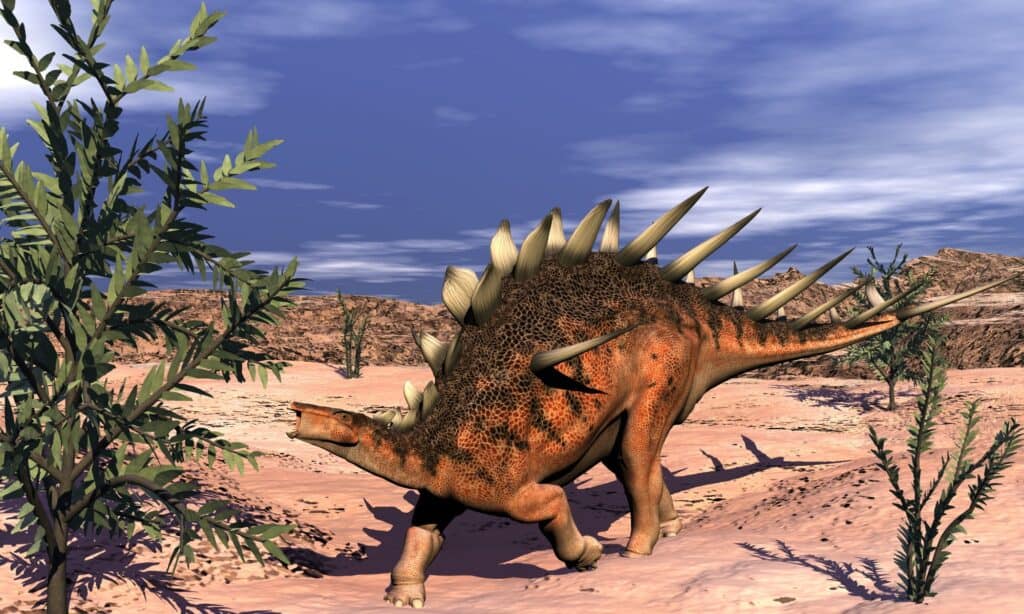
This dinosaur had a large body, but its head is tiny, and its brain is only about the size of a walnut.
©Elenarts/Shutterstock.com
A genus of the Stegosauridae family, Knetrosaurus lived during the late Jurassic Period in what is now Tanzania, East Africa. Kentrosaurus was a herbivore and fed on low-lying vegetation that was around 3 feet tall. To keep safe, this species traveled in large groups.
Kentrosaurus measured around 15 feet long (4.57 meters), and weighed between 2,200 to 6,600 lbs (997.9 – 2721.5 kg). They were slightly smaller than the North American Stegosaurus. Spikes cover their body and tail. The Knetorsaurus’ long spikes made it harder for predators to successfully attack them. Attracting mates is another possible use for their spikes. Like other armored dinosaurs, they used their tails to bludgeon and keep enemies at bay.
3. Pachycephalosaurus
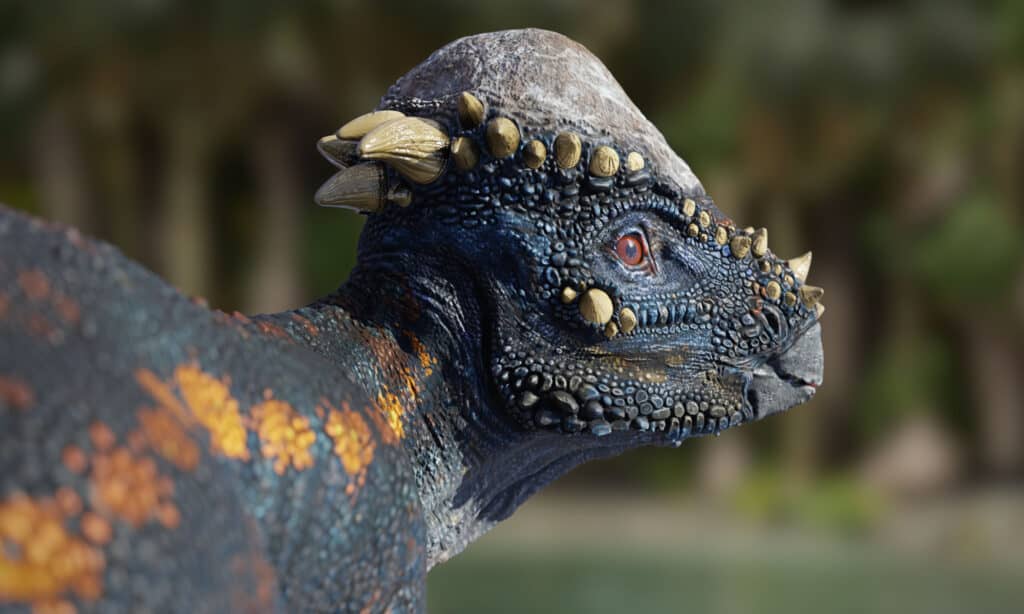
The large domed skull on the Pachycephalosaurus has a similar use to the horns of a ram.
©Dotted Yeti/Shutterstock.com
The Pachycephalosaurus is a herbivorous, and bipedal dinosaur. This species lived 65 to 100 million years ago during the Late Cretaceous period. Pachycephalosaurus inhabited what is now North America. Fossils have been uncovered in Alberta, Canada, Montana, South Dakota, and Wyoming. Pachycephalosaurus are Ornithopoda dinosaurs, and their spikes are much less prominent than that of an armored dinosaur.
Two species of this genus exist currently:
- Pachycephalosaurus grangeri
- Pachycephalosaurus reinheimeri
This dinosaur stood around 6 feet tall (1.8 meters), and had a large length between 15 to 16 feet (4.5 to 4.8 meters). One of its most impressive features is its thick skull, which is 10 inches thick (25 cm). The skull of the Pachycephalosaurus is 10 times thicker than the average dinosaur. Small spikes protruded out of their skull, as well as onto their face. Their hard skull let them batter whatever got in their way, similar to a ram.
4. Polacanthus

The large spikes and rows of armor on the Polacanthus made it a dangerous dinosaur for any predator to attempt to kill.
©Warpaint/Shutterstock.com
[Dinosaur Polcanthus image-caption- ]
Polacanthus are armored dinosaurs that lived in the Early Cretaceous period. Living around 130 to 125 million years ago, they inhabited western Europe and left fragments of fossils there. This dinosaur was terrestrial and survived off an herbivore diet. Only partial fossils of this dinosaur has been discovered, however, other similar species have helped depict what this dinosaur could have looked like.
Polacanthus grew to around 16 feet (5 meters), and also had a hard armor covering. They stand around 7 feet tall (2.13 meters), and have spikes along their body and tail for defense. Running at the speed of a rhino, they are a heavy 2 metric tons (4409 lbs) when fully grown.
5. Dacentrurus
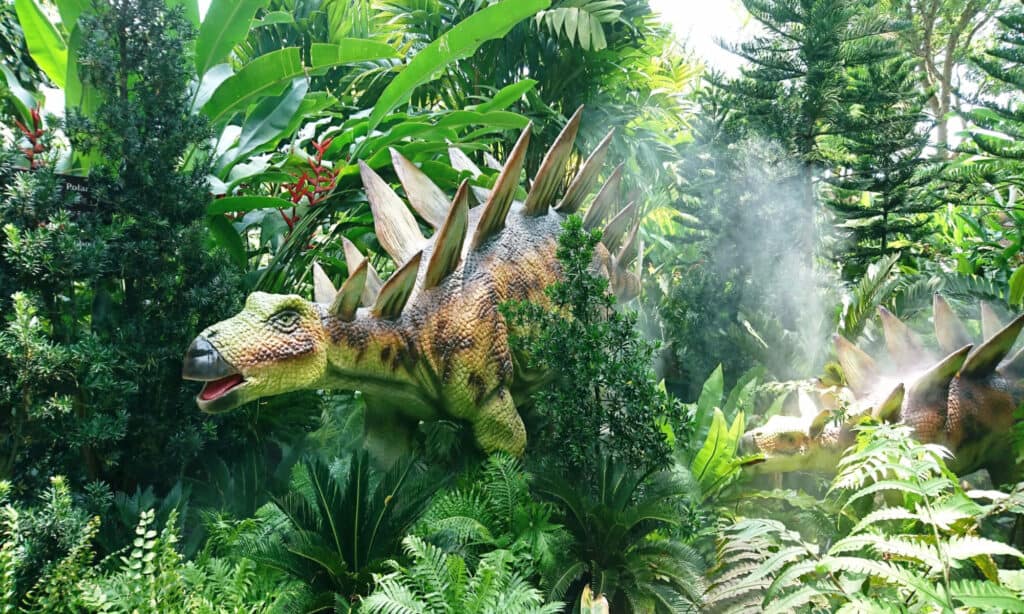
The Dacentrurus has two large rows of spikes running down its body, which is unique since one row is more common.
©Cheng Wei/Shutterstock.com
The Dacentrurus lived during the Late Jurassic period and is a large Stegosauridae species. They reached a length of around 23 to 26 feet (7 to 8 meters) and weighed up to 5 tons (10000 lbs). Dacentrurus lived until the late Cretaceous extinction event and inhabited what is now Europe. 20 fossil specimens of this dinosaur have been discovered. Spain, France, and the United Kingdom are some of the areas this species’ remains were discovered in.
Dacentrurus were herbivores and moved on all fours. Like other armored dinosaurs, they had plates, and spikes covering their body. The spikes along their body and tail are in two rows, unlike other species of Stegosauridae, which usually only have one row of spikes.
6. Dicraeosaurus
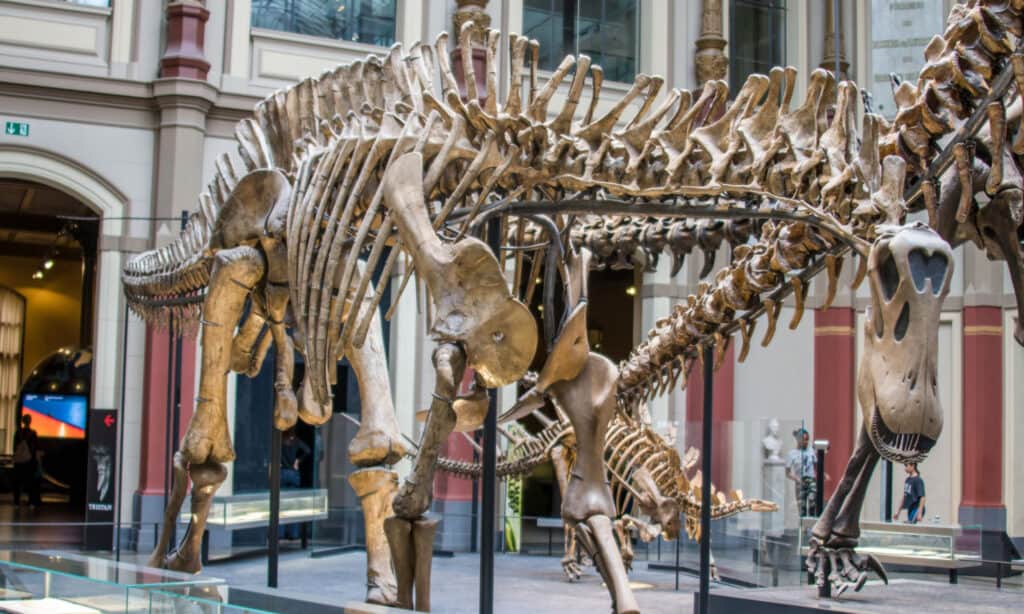
The Dicraeosaurus is a large sauropod dinosaur with spines running along its spine.
©Danny Ye/Shutterstock.com
When thinking of a spiky dinosaur, most people think of species like the Stegosaurus or Ankylosaurus, but the Dicraeosaurus is a genus of long-necked Sauropod that also have spikes on them. Dicraeosaurus have spikes or spines that protrude out of its back. Standing at 39 feet, (12 meters) this species was extremely large. Even with its large size, it was still smaller than the average length of other Sauropods, which is around 50 feet (15 meters).
Dicraeosaurids lived in Africa, during the late Jurrasic period. They were herbivores and fed on low-lying vegetation. Named after the spines that come out of their back, Dicraesourds were discovered first in 1914, by German Paleontologist Werner Janesch. A giant of its time, the Dicraeosursu is estimated to have weighed 8.8 tons (8,000 kg). They walked on all fours and their large size slowed them down tremendously.
7. Chungkingosaurus
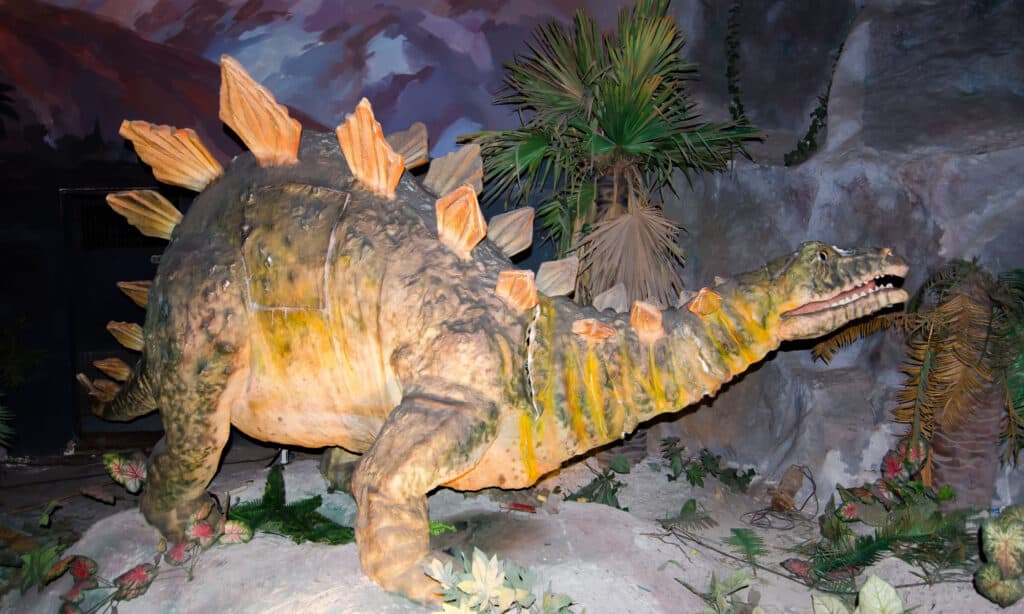
Chungkingosaurus ws first discovered in 1977.
©ArliftAtoz2205/Shutterstock.com
In 1977 the Chungkingosaurus was discovered and dug up in China around the Upper Shaximiao Formation. This species lived during the late Jurrasic period. As one of many members of the Stegosauridae family, the Chungkingosaurus was a herbivore and walked on all fours. They lived in forest-type habitats. This species lived in groups with other similar dinosaurs.
Chungkingosaurs had spikes running down its back arranged in pairs. The spikes protruded out of their back, and out the sides of the tail. Like other similar species, the spikes on its tail were used to defend itself from other land predators.
8. Gastonia
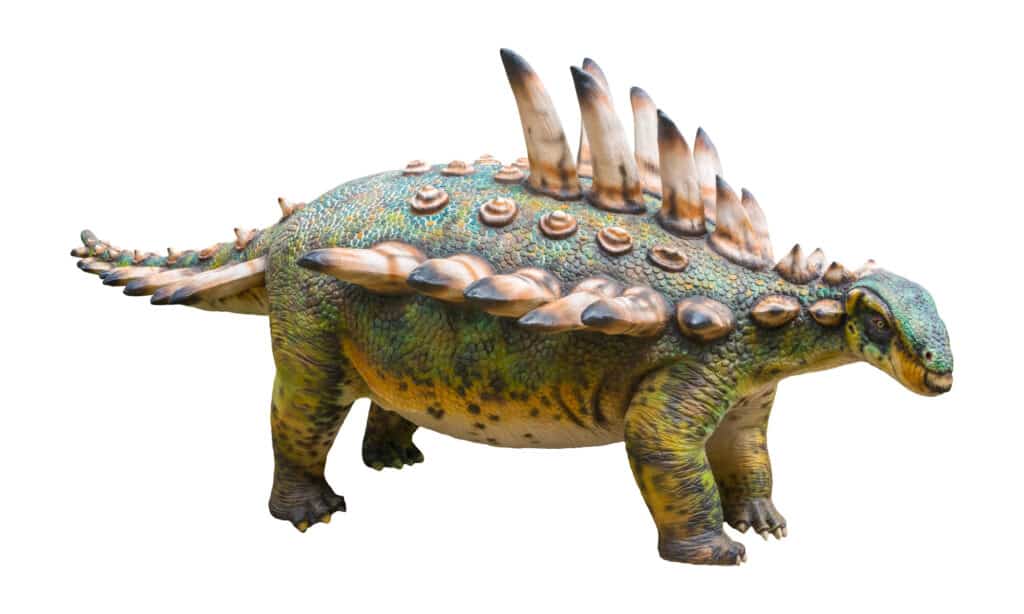
Gastonia fossils are some of the most well preserved amongst its relatives.
©YuRi Photolife/Shutterstock.com
The Gastonia is a dinosaur that lived 139 to 125 million years ago, in what now is considered North America. This species was an ankylosaurian dinosaur, sharing common traits with other Ankylosaurids like walking on all fours, a herbivorous diet, and armor covering its body. Gastonia fossils were first discovered in the lower Cedar Mountain Formation of Utah. In 1998 Robert Gaston discovered this dinosaur and also inspired the name of this species.
Gastonia had large spikes covering their body and tail. These spikes helped the species survive while living amongst predators. Gastonia were a medium-sized species, weight around 4,200 lbs (1905 kg) and had a large length of 16 feet (4.8 meters)
9. Stegosaurus
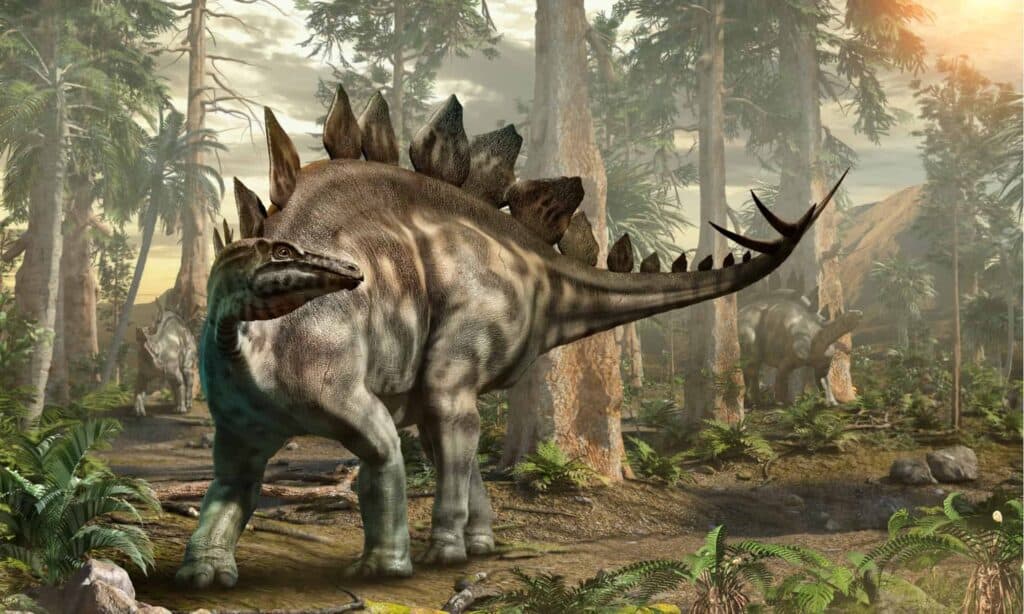
There have been around 80 different Stegosaurus specimens that have been discovered around the world.
©Warpaint/Shutterstock.com
Stegosaurus were large dinosaurs with an iconic spike and plate appearance. Living during the late Jurassic period 155 -145 million years ago, the Stegosaurus is one of the world’s most recognizable dinosaurs. Fossils have been found in the United States, China, South Africa, India, and Europe.
There are three known Stegosaurus species, S. stenops, S. ungulatus, and S. sulcatus.
The Stegosaurus was a large species, measuring between 21 to 30 feet long (6.5 – 9 meters). They survived on a herbivore’s diet and had an estimated weight of around 6,800 lbs (3084.42 kg). Walking on all fours, their tails were long and thick. Spikes at the end of their tail made it possible to defend themselves from the fiercest of predators. On their back sat large plates, which they used to show off. Stegosaurus had an extremely tiny head for its size, and only had a brain the size of a walnut.
The photo featured at the top of this post is © YuRi Photolife/Shutterstock.com
Thank you for reading! Have some feedback for us? Contact the AZ Animals editorial team.






